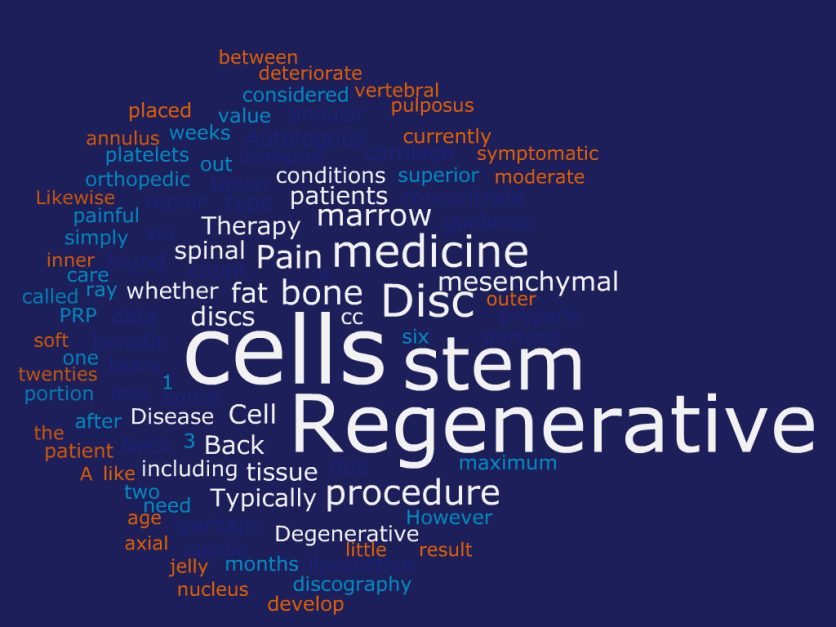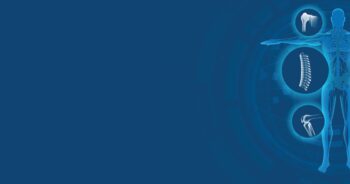
Am I a Candidate for Regenerative Medicine?
For spinal conditions, the primary condition where stem cells may be of value is recent MRI-confirmed symptomatic degenerative disc disease of mild to moderate degree that is causing axial neck or back pain. Stem cells would be of little value for radicular pain (radiating pain to an arm or a leg) as a result of a disc herniation or spinal stenosis. Likewise, stem cells would be of little value for advanced degenerative disc disease, facet joint pain, myofascial soft tissue strain or spasm, spinal instability, vertebral compression fractures, scoliosis, or spinal deformity.
Back Pain & Degenerative Disc Disease
The intervertebral discs in our spines are shock absorbers, or cushions, between the vertebral bones of the spine. Think of the discs as a jelly donut
with an inner jelly-like portion, called the nucleus pulposus, and an outer dough-like portion, named the annulus. Beginning in our twenties, the discs in our spine begin to deteriorate with advancing age, but these discs also deteriorate due to wear and tear and in some, genetic predisposition. The discs may develop tears in the annulus (the outer wall) as well as dessicate (lose hydration). In these annular tears, tiny nerves may grow. The nucleus pulposus (the inner portion of the disc) contains chemicals that are highly irritating to surrounding tissue including these nerves that grow into the annular tears.
A common cause of chronic axial low back or neck pain in patients in their twenties to fifties, peaking at age forty, is degenerative disc disease. However, determining whether a particular disc is the source of one’s back or neck pain can be a challenge. Typically, lower back pain from disc degeneration is intermittent; it becomes worse with prolonged standing or sitting, bending forward, coughing, sneezing, or vibration (i.e. riding in a car). This type of pain is typically restricted to the back, buttocks, or back of the upper thighs.
To aid in the diagnosis of disc induced pain, some advocate the use of a diagnostic procedure called provocative discography. During this procedure, a volume of contrast dye is injected into the disc at a measured pressure that is typically not painful or even noticed by the patient when placed in a healthy asymptomatic disc. In a symptomatic disc, however, this procedure creates a significant reproduction of the location and character of the usual pain. There is currently no consensus whether provocative discography needs to be done in order to decide to do a stem cell procedure because it is not a fully reliable test. Fortunately, discography carries a very low risk of disc infection or even further disc degeneration.
Using Stem Cells in the United States
Regenerative therapy for spinal conditions in the United States, as dictated by the FDA (Food & Drug Administration), is currently limited to utilizing autologous (a patient’s own) adult stem cells found in either bone marrow or fat, with minimal manipulation of the collected cells, and gathered at point of care. The injected cells are not processed in a laboratory; there is no risk of immune rejection or development of cancer with autologous cells. This therapy does not include the use of embyronic stem cells and should not be confused with platelet rich plasma (PRP). PRP simply concentrates the platelets found naturally in blood and is not mesenchymal stem cell therapy, but rather contains a very small number of hematopoietic stem cells that do not develop.
The goal of injecting stem cells into the degenerated discs is to heal the disc by potentially closing the annular tears and rebuilding the disc via development of new disc cartilage cells, called chondrocytes. These multipotent stem cells differentiate (or specialize) into healthy chondrocytes when placed into the disc via environmental signals. Stem cells are undifferentiated cells that can either self-renew or differentiate into a specific cell type to repair or regenerate damaged tissue. Stem cells from bone marrow and fat are multipotent mesenchymal cells, which means that they have potential to develop into different types of cells, including cartilage.
Bone marrow aspirate contains platelets, immune cells, mesenchymal stem cells, and hematopoietic stem cells. Thus, there is no need to add additional platelets via PRP. Mesenchymal stem cells exert their effect not only by proliferation of new cells including cartilage, but may also act by regulating surrounding tissue, immune modulation, and anti-inflammation.
For orthopedic conditions, including the environment in spinal discs, bone marrow-derived mesenchymal cells may be superior to fat-derived mesenchymal cells. Mesenchymal cells in bone marrow are more closely related to the type of cells that are needed for orthopedic conditions than those found in fat, despite a higher number found in fat. In fact, the studies published to date far more strongly support bone marrow-derived over fat-derived stem cells for orthopedic conditions involving bone repair, cartilage repair, or soft-tissue ligamentous repair, likely due to the homologous nature of this route. Furthermore, while there may be claims that fat may provide a higher count of mesenchymal stem cells than bone marrow, this may not be valid as these cells may simply be fat tissue.
Collecting the stem cells by aspiration from bone marrow, especially under x-ray guidance, is much less invasive and better tolerated than a liposuction procedure. A simple needle lipoaspiration may be less invasive than liposuction but is unlikely to do much more than provide fat tissue. Furthermore, to properly obtain stem cells from the fat after liposuction, an enzyme such as collagenase is likely needed to separate out the stem cells. However, doing this may be in violation of the FDA’s rule for minimal manipulation of cells and it is unclear whether adding this or another enzyme may damage or perhaps modify these cells with unanticipated negative consequences.
What to Expect
An autologous bone marrow concentrate injection into the spinal disc typically involves an outpatient procedure (meaning the patient is discharged on the same day of the procedure) at a surgical center. Local anesthesia and perhaps light sedation may be utilized.
The bone marrow aspirate is typically taken from the posterior hip bone (posterior superior iliac spine) but may also be taken from the anterior hip bone (anterior superior iliac spine) under x-ray guidance. With ample local anesthetic placed, most patients do not find this part of the procedure to be too painful and is often considered the least painful aspect of the procedure. Approximately 60 cc are taken from one site. Likewise, the placement of cells into the disc is done via needle placement under x-ray guidance. A specialized centrifuge system processes the autologous bone marrow concentrate at the point of care, with a way to separate out and maximize the largest amount of stem cells. Approximately 3 cc of the highest concentrate cells, with another 7cc of a lesser concentrate cells result. An average lumbar disc can hold around 2-3 cc maximum, while the average cervical disc can hold around 1 cc maximum. Typically, most patients have 1, sometimes 2, discs treated, and rarely 3 discs at a setting. The entire procedure takes less than an hour from start to finish. Caution must be taken for those with anemia, bleeding disorders, active infection, immune system disorders, or patients on blood thinners.
By putting any type of volume or pressure into the disc, whether it be one’s own cells or any type of liquid, it is common to have temporary increased pain for up to several days post procedure. Most patients do not notice the benefit of the procedure until four to 12 weeks after, with most reporting improvement by 10 to 12 weeks after. Typically, the maximum benefit is noted between three and six months afterward. Most patients should only require a single procedure and published data has shown persisting benefit achieved at three to six months out to at least one to two years. There is not yet data available as to whether the benefit persists after one to two years. There is also no clear data whether there is any need for supplementation orally or intravenously in addition to the stem cell procedure. There is data to suggest that patients should avoid non-steroidal anti-inflammatory drugs (NSAIDs), like ibuprofen or naproxen, or steroids for up to two weeks before and after, as these drugs may impair the regenerative process. Activity can be gradually resumed after the procedure and there is no clear need for bracing or specific physical therapy protocol.
Final Takeaways
It cannot be emphasized enough that currently, regenerative medicine is considered investigational and is not covered by insurance. This is an evolving field with continued contribution from basic science, clinical studies, and physician consensus guidelines in progress. As of now, this field is still relatively young and what is considered cutting-edge today may be totally outdated tomorrow.
It is vital that any patient considering this therapy must carefully evaluate any physician or clinical center offering such procedures with regards to ensuring the highest level of experience, training, safety, and ethics are present. Bone marrow aspiration technique, centrifuge equipment utilized (with regard to not simply total cell count but actual cell recovery as measured by colony forming units, not total nucleated cell count, to properly reflect mesenchymal cell count), and proper technique to properly and safely place the needle into the disc are vital to the success of the procedure. In addition, this treatment option should only be considered for moderate to severe pain of six months or more duration that has not responded to conservative options including medication, physical therapy, or chiropractic care, and likely facing spine surgery as the only other option.
Read the full article from the Spring 2015 Journal.
By Steven Barna, MD


